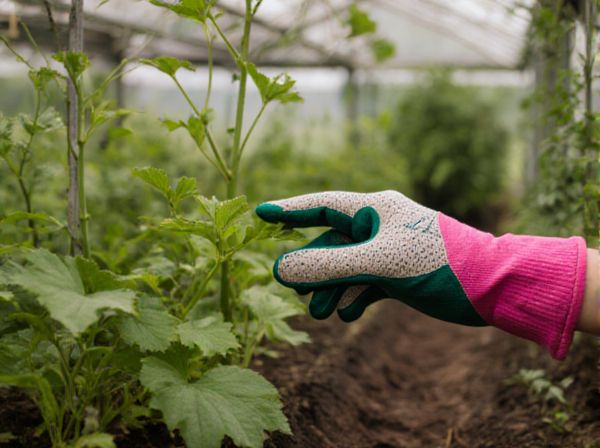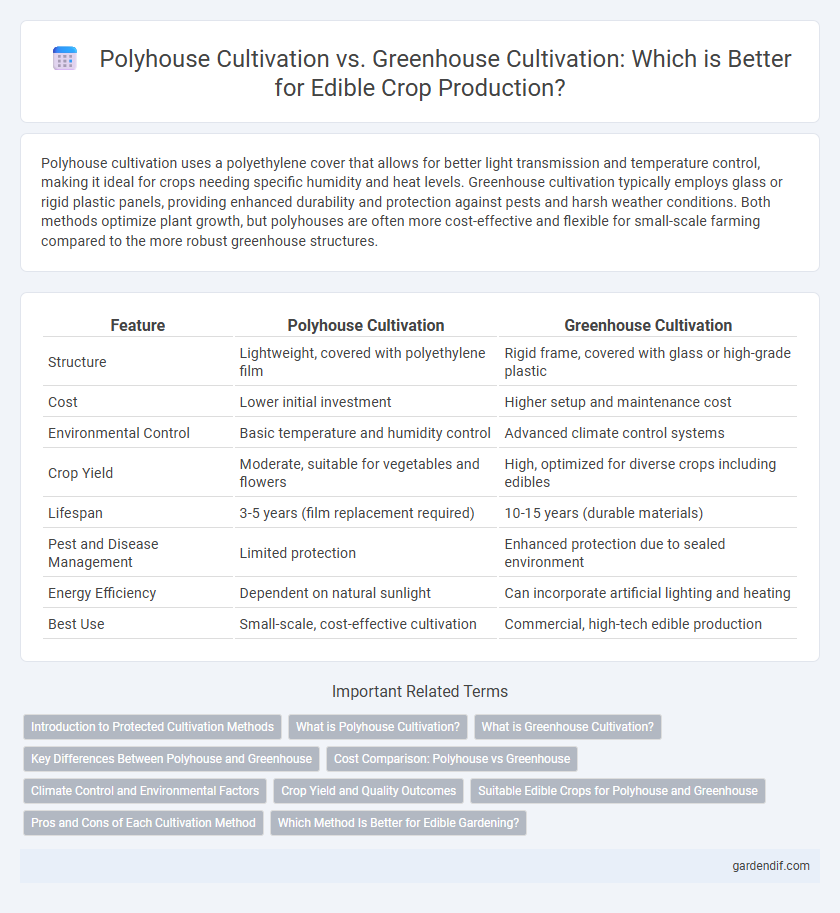
Polyhouse Cultivation vs Greenhouse Cultivation Illustration
Polyhouse cultivation uses a polyethylene cover that allows for better light transmission and temperature control, making it ideal for crops needing specific humidity and heat levels. Greenhouse cultivation typically employs glass or rigid plastic panels, providing enhanced durability and protection against pests and harsh weather conditions. Both methods optimize plant growth, but polyhouses are often more cost-effective and flexible for small-scale farming compared to the more robust greenhouse structures.
Table of Comparison
| Feature | Polyhouse Cultivation | Greenhouse Cultivation |
|---|---|---|
| Structure | Lightweight, covered with polyethylene film | Rigid frame, covered with glass or high-grade plastic |
| Cost | Lower initial investment | Higher setup and maintenance cost |
| Environmental Control | Basic temperature and humidity control | Advanced climate control systems |
| Crop Yield | Moderate, suitable for vegetables and flowers | High, optimized for diverse crops including edibles |
| Lifespan | 3-5 years (film replacement required) | 10-15 years (durable materials) |
| Pest and Disease Management | Limited protection | Enhanced protection due to sealed environment |
| Energy Efficiency | Dependent on natural sunlight | Can incorporate artificial lighting and heating |
| Best Use | Small-scale, cost-effective cultivation | Commercial, high-tech edible production |
Introduction to Protected Cultivation Methods
Polyhouse cultivation involves growing plants under a semi-controlled environment using transparent polyethylene covers, allowing protection from extreme weather and pests while optimizing light transmission for enhanced growth. Greenhouse cultivation offers a fully controlled environment with advanced climate regulation systems, enabling precise management of temperature, humidity, and CO2 levels to maximize crop yield and quality. Both protected cultivation methods improve resource use efficiency and extend growing seasons compared to open-field farming.
What is Polyhouse Cultivation?
Polyhouse cultivation involves growing crops under a specially designed structure made of polythene sheets that regulate temperature, humidity, and light, creating an optimal environment for plant growth. This method significantly reduces exposure to external weather conditions, pests, and diseases, enhancing crop yield and quality. By using controlled ventilation and irrigation systems, polyhouse cultivation maximizes water efficiency and nutrient management for high-value horticultural crops.
What is Greenhouse Cultivation?
Greenhouse cultivation involves growing plants within a controlled structure made of transparent materials like glass or plastic, allowing regulation of temperature, humidity, and light to optimize plant growth. This method protects crops from adverse weather conditions, pests, and diseases, enhancing yield and quality. Common in edible crop production, greenhouse cultivation ensures year-round farming with better resource efficiency compared to traditional open-field methods.
Key Differences Between Polyhouse and Greenhouse
Polyhouse cultivation utilizes polyethylene sheets as a covering material, offering lightweight and cost-effective protection, whereas greenhouse cultivation employs glass or rigid plastic panels providing better insulation and durability. Polyhouses are ideal for temperature and humidity control in moderate climates, while greenhouses support advanced climate control systems suitable for high-value crops requiring precise environmental regulation. The structural rigidity and lifespan of greenhouses surpass polyhouses, influencing crop yield stability and long-term investment decisions in controlled environment agriculture.
Cost Comparison: Polyhouse vs Greenhouse
Polyhouse cultivation generally incurs lower initial construction and maintenance costs compared to greenhouse cultivation due to the use of polyethylene sheets instead of expensive glass panels. Operating expenses such as energy consumption are typically reduced in polyhouses because of better insulation and natural ventilation, making them more cost-effective for small to medium-scale horticulture. However, greenhouses offer superior environmental control, which can justify their higher cost for high-value crops requiring precise climate management.
Climate Control and Environmental Factors
Polyhouse cultivation provides superior climate control by using UV-stabilized polyethylene covers that regulate temperature, humidity, and light intensity more effectively than greenhouse cultivation, which often relies on glass or rigid plastic panels. Polyhouse environments can maintain optimal conditions for crop growth by minimizing external weather fluctuations, reducing pest incidence, and enhancing CO2 levels. In contrast, greenhouses may experience greater temperature variability and less efficient ventilation, impacting crop yield and quality.
Crop Yield and Quality Outcomes
Polyhouse cultivation enhances crop yield by providing controlled environmental conditions that reduce pest incidence and optimize temperature and humidity levels, resulting in uniform and high-quality produce. Greenhouse cultivation, while also offering protection and extended growing seasons, often leads to slightly lower yields due to variable light penetration and less precise climate control. Both methods improve crop quality compared to open-field farming, but polyhouses typically deliver superior quality outcomes in terms of texture, flavor, and nutritional value.
Suitable Edible Crops for Polyhouse and Greenhouse
Polyhouse cultivation excels in growing high-value, small to medium-sized edible crops like tomatoes, capsicum, strawberries, and leafy greens due to its controlled temperature and humidity environment. Greenhouse cultivation supports a wider variety of edible crops, including cucumbers, melons, and flowers, benefiting from more robust structural protection and automated climate control systems. Both systems enhance crop yield and quality by providing optimized growing conditions tailored to specific edible plants.
Pros and Cons of Each Cultivation Method
Polyhouse cultivation offers superior control over temperature, humidity, and pest management, boosting crop yield and quality but requires higher initial investment and energy consumption. Greenhouse cultivation provides a more natural environment with better ventilation and light diffusion, reducing disease risk and operational costs, yet it is more susceptible to external weather fluctuations. Both methods enhance year-round production, but polyhouse systems are ideal for high-value crops needing precise climate control, while greenhouses suit crops tolerant to variable conditions.
Which Method Is Better for Edible Gardening?
Polyhouse cultivation offers better control over temperature, humidity, and pest management, making it ideal for high-value edible crops requiring stable conditions. Greenhouse cultivation provides greater versatility with transparent structures that maximize sunlight for a diverse range of vegetables and fruits. For edible gardening, polyhouses are often preferred for precision farming, while greenhouses excel in fostering plant growth through natural light optimization.
Polyhouse Cultivation vs Greenhouse Cultivation Infographic

 gardendif.com
gardendif.com